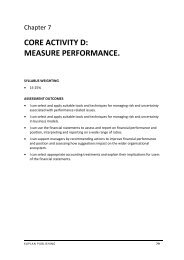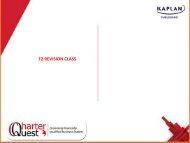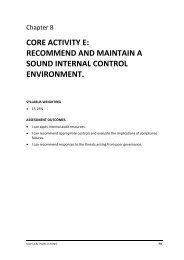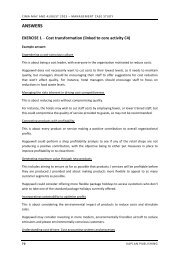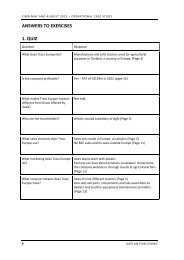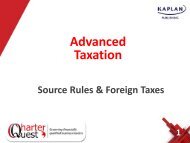You also want an ePaper? Increase the reach of your titles
YUMPU automatically turns print PDFs into web optimized ePapers that Google loves.
ACCA<br />
<strong>APM</strong> <strong>LECTURE</strong>R:<br />
Munyaradzi Dera<br />
ACMA, CGMA, B.Sc.<br />
Honours Economics<br />
Email:<br />
mdera@gmail.com<br />
Mobile/Whatsapp:<br />
+27 73 665 6728
STUDENT SUPPORT:<br />
Study Materials: Hardcopy / eBooks<br />
Admin Support<br />
cqops@charterquest.co.za<br />
eCampus student portal<br />
ecampus@charterquest.co.za<br />
PC Exams<br />
pcexams@charterquest.co.za<br />
Bookstores<br />
bookstores@charterquest.co.za<br />
Student Billing/Accounts<br />
accounts@charterquest.co.za<br />
Support Escalation (COO/CEO)<br />
enquiries@charterquest.co.za<br />
Whatsapp group for support from your Lecturer,<br />
admin team and group discussions
SYLLABUS<br />
STRUCTURE
SYLLABUS STRUCTURE<br />
1
SYLLABUS STRUCTURE<br />
1
SYLLABUS STRUCTURE<br />
1
ACCA ADDITIONAL RESOURCES
ACCA ADDITIONAL RESOURCES - CBE<br />
01<br />
Advanced Performance Management
ACCA ADDITIONAL RESOURCES - Study Hub<br />
02
ACCA ADDITIONAL RESOURCES - SH<br />
02
ACCA ADDITIONAL RESOURCES - SH<br />
02
ACCA ADDITIONAL RESOURCES - SH<br />
02
01<br />
ACCA <strong>APM</strong><br />
<strong>LECTURE</strong> 1<br />
03<br />
0<br />
06
Main capabilities<br />
On successful completion of this exam,<br />
candidates should be able to:<br />
A. Use strategic planning and control<br />
models to plan and monitor<br />
organisational performance.<br />
B. Apply a range of professional skills<br />
in addressing requirements within<br />
the Advanced Performance<br />
Management exam, and in<br />
preparation for, or to support, current<br />
work experience<br />
C. Identify and evaluate the design<br />
features of effective performance<br />
management information and<br />
monitoring systems and recognise<br />
the impact of developments in<br />
technology on performance<br />
measurement and management<br />
systems.<br />
D. Apply appropriate strategic<br />
performance measurement<br />
techniques in evaluating and<br />
improving organisational<br />
performance<br />
E. Advise clients and senior<br />
management on strategic business<br />
performance evaluation and on<br />
recognising vulnerability to<br />
corporate failure.<br />
01<br />
03<br />
0<br />
06<br />
F. Employability and technology skills
01<br />
03<br />
0<br />
06
03<br />
0<br />
06
03<br />
0<br />
06
03<br />
0<br />
06
03<br />
0<br />
06
03<br />
0<br />
06
03<br />
0<br />
06
03<br />
0<br />
06
03<br />
0<br />
06
03<br />
0<br />
06
03<br />
0<br />
06
03<br />
0<br />
06
03<br />
0<br />
06
03<br />
0<br />
06
03<br />
0<br />
06
03<br />
0<br />
06
03<br />
0<br />
06
03<br />
0<br />
06
03<br />
0<br />
06
Chapter 1<br />
Introduction to strategic management accounting<br />
EXAM-FOCUSSED/LEARNING OUTCOMES:<br />
1. Explain the role of strategic performance management in strategic planning and<br />
control.<br />
2. Discuss the role of performance measurement in checking progress towards the<br />
corporate objectives.<br />
3. Compare planning and control between the strategic and operational levels within<br />
a business entity.<br />
01<br />
4. Discuss the scope for potential conflict between strategic business plans (longterm)<br />
and short-term localised decisions.<br />
5. Evaluate how models such as: SWOT analysis, PEST, BCG, Balanced<br />
scorecard, Porter's generic strategies and 5 Forces may assist in the<br />
performance management process.<br />
6. Apply and evaluate the methods of benchmarking performance.<br />
7. Discuss how the purpose, structure and content of a mission statement impacts<br />
on performance measurement and management.<br />
03<br />
8. Discuss how strategic objectives are cascaded down the organisation via the<br />
formulation of subsidiary performance objectives<br />
9. Apply critical success factor analysis in developing performance metrics from<br />
business objectives.<br />
0<br />
10. Identify and discuss the characteristics of operational performance.<br />
11. Discuss the relative significance of planning against controlling activities at<br />
different levels of the performance hierarchy.<br />
12. Explore the role of the management accountant in providing key performance<br />
information for integrated reporting to stakeholders.<br />
13. Assess the appropriate benchmarks to use in assessing performance.<br />
14. Assess the statement 'what gets measured gets done' in the context of<br />
performance management.<br />
06
01<br />
03<br />
0<br />
06
01<br />
0<br />
06
01<br />
03<br />
0<br />
06
01<br />
Bruns and Scapens includes management structures<br />
03<br />
0<br />
06
01<br />
03<br />
0<br />
06
01<br />
0<br />
06
01<br />
0<br />
06
01<br />
0<br />
06
01<br />
0<br />
06
Section A – This ONE question is compulsory and MUST be<br />
attempted<br />
1 Thyme Engine Products (Thyme): Company information<br />
Thyme manufactures jet aircraft engines for the commercial aircraft<br />
market. This is a worldwide business although Thyme’s production and<br />
development are all based in the country of Beeland. Thyme is a listed<br />
company 01 and its stated overall objective is to be ‘a world-class jet engine<br />
manufacturer trusted by our customers to deliver excellent products’. Its<br />
promise to its shareholders is that it will maximise their returns. The<br />
strategy to achieve this is to use world-class engineering to design engines<br />
and high quality production and customer service in order to drive<br />
profitable growth.<br />
Thyme’s share price has recently suffered as a result of the failure of a new<br />
engine design which led to large cash losses and a difficulty in obtaining<br />
new financing. There has also been a bribery scandal involving a senior<br />
manager and one of its key customers. As a result, a new chief executive<br />
officer (CEO) has been employed and she has begun a major review of<br />
systems at Thyme.<br />
The first area which the CEO wants to examine is the information given to<br />
the board for strategic decision-making in both the planning and controlling<br />
0<br />
of the business. The government of Beeland has been encouraging<br />
information sharing between businesses and has recently sponsored<br />
awards for management accounting. The winner of the engineering sector<br />
has produced a sample dashboard template (with dummy figures) for an<br />
annual review and this is given in Appendix 1. The CEO realised that the<br />
winner had a very similar overall objective and strategies to Thyme and<br />
wants to know what it is about this dashboard that helped it win the award.<br />
She does not want a new dashboard for Thyme at this stage but there may<br />
be some useful, specific comments to make about the contents of the<br />
dashboard given Thyme’s recent problems.<br />
06
1 Thyme Engine Products (Thyme): Company information Continued<br />
The CEO has also recently been reading about integrated reporting and<br />
in the light of this review of the dashboard, the CEO has also asked for<br />
your views on how integrated reporting might impact on the type of<br />
information prepared by the company’s management accountants.<br />
As high quality engineering products lie at the heart of Thyme’s<br />
competitive advantage, there has been a total quality management (TQM)<br />
approach to the management of all resources and relationships<br />
throughout the business. Thyme currently has a project under<br />
consideration to develop a new simple jet engine which would compete in<br />
the crowded market for small corporate jets. In order to compete in this<br />
market, it is believed that a target costing approach to this new engine<br />
would be beneficial. The CEO wants you to calculate the target cost gap<br />
for the new engine using the data in Appendix 2. Next, she wants to know<br />
how the use of target costing would fit within the existing TQM approach<br />
for this new engine.<br />
The new engine project has further raised the profile of quality as a broad<br />
issue at Thyme and the CEO wants your advice on the costs associated<br />
with quality. She needs to know the cost of each of the four categories of<br />
quality costs. She has gathered data in Appendix 3 for this exercise. She<br />
is happy that she has identified that prevention costs are complete but is<br />
worried that some of the possible costs for the other three categories are<br />
missing and needs suggestions of cost areas to be examined to identify<br />
these missing items. Finally, she needs advice on the relative importance<br />
to Thyme of each of the four categories.<br />
Required:<br />
Write a report to the CEO of Thyme to:<br />
(i)<br />
(ii)<br />
Evaluate why the dashboard in Appendix 1 was award winning, as requested<br />
by the CEO. (15 marks)<br />
01<br />
Explain broadly the role of the management accountant in providing<br />
information for integrated reporting. (6 marks)<br />
(iii) Calculate the target cost gap for the new engine (using Appendix 2) and<br />
assess how the use of this target cost will fit within the TQM approach. (12<br />
marks)<br />
(iv) Categorise and calculate the costs of quality at Thyme (given in Appendix 3).<br />
Suggest cost areas to be examined as required by the CEO, and evaluate the<br />
relative importance of each category to Thyme. (13 marks).<br />
Professional marks will be awarded for the format, style and structure of the<br />
discussion of your answer. (4 marks)<br />
(50 marks)<br />
0<br />
06
01<br />
0<br />
06
01<br />
0<br />
06
Ganymede University (GU) is one of the three largest universities in Teeland, which<br />
has eight universities in total. All of the universities are in the public sector. GU<br />
obtains the vast majority of its revenue through government contracts for academic<br />
research and payments per head for teaching students. The economy of Teeland<br />
has been in recession in the last year and this has caused the government to cut<br />
funding for all the universities in the country.<br />
In order to try to improve efficiency, the chancellor of the university, who leads its<br />
executive board, has asked the head administrator to undertake an exercise to<br />
01<br />
benchmark GU’s administration departments against the other two large universities<br />
in the country, AU and BU. The government education ministry has supported this<br />
initiative and has required all three universities to cooperate by supplying<br />
information. The following information has been collected regarding administrative<br />
costs for the most recent academic year:<br />
0<br />
06
The key drivers of costs and revenues have been assumed to be<br />
research contract values supported, student numbersand total staff<br />
numbers. The head administrator wants you to complete the<br />
benchmarking and make some preliminarycomment on your results.<br />
Required:<br />
(a)Assess the progress of the benchmarking exercise to date,<br />
explaining the actions that have been undertaken and those that are<br />
still required. (10 marks)<br />
(b)Evaluate, as far as possible, Ganymede University’s<br />
benchmarked position. (15 marks)(25 marks)<br />
(a)Assess the progress of the benchmarking exercise to date, explaining the actions that have<br />
been undertaken and those that are still required. (10 marks)<br />
The benchmarking process is often described using seven steps. The following are the steps<br />
with the current state of the exercise:<br />
1. Set objectives and decide the areas to benchmark: GU has set the objective of<br />
improving efficiency and is benchmarking all of its administration operations relating to<br />
teaching and research.<br />
01<br />
2. Identify key performance drivers and indicators: The performance drivers have been<br />
provided and the indicators are based on the activity per driver. The drivers might be<br />
improved by distinguishing between teaching staff and administrative staff.<br />
3. Select organisations for benchmarking comparison: The government selected the<br />
three largest universities for benchmarking which excludes five other smaller universities.<br />
This can be justified if the large universities cover similar teaching and research areas<br />
while the smaller ones are narrower in focus (for example science and engineering<br />
subjects only). However, it may be that there are examples of good practice in university<br />
administration that will be missed as a result of restricting the exercise. It might be sensible<br />
to include foreign universities in the exercise. Differences in the mix of subjects researched<br />
and taught might also affect the results (e.g. managing teaching facilities in engineering<br />
and law will be different).<br />
4. Measure performance of all organisations involved in benchmarking: The basic data<br />
has been gathered as required by government. This step would normally be more complex<br />
in a private sector situation as commercial secrecy would hinder the sharing of information.<br />
0<br />
5. Compare performances: This is the stage that has been reached. See answer to part (b)<br />
for results.<br />
6. Specify improvement projects: The results of the comparison should lead to<br />
identification of areas for improvement. If GU is not demonstrating leading performance<br />
then it should send staff to the top performer to identify their best practice processes and<br />
devise projects to implement these at GU.<br />
7. Implement and monitor improvements: Management should perform a post-project<br />
review in order to identify if the improvement has achieved or exceeded its goals and<br />
06<br />
consider lessons that have been learned from the project.
(b)Evaluate, as far as possible, Ganymede University’s benchmarked position. (15<br />
marks)(25 marks)<br />
In accounting services, all the universities perform broadly in<br />
line. BU has achieved a small 3·5% advantage over the others.<br />
01<br />
In human resources management, BU is 22% more costly<br />
which is surprising given the larger staff numbers at BU over<br />
which to spread such a central cost.<br />
In IT management, there is some variation of performance with<br />
BU costs being 10% lower than GU’s. These variations may<br />
well be due to the subjects being taught (for example,<br />
universities that are more orientated to science and technology<br />
will probably demand larger computing resources).<br />
In general services, all the universities perform broadly in line.<br />
AU has achieved a small 3% advantage over GU.<br />
Research categories are considered per $000 of contract value supported. Teaching<br />
facilities and student support are considered per student. Other categories are considered<br />
per staff member.<br />
From the results, it can be seen that GU is best at controlling costs associated with research<br />
contracts and it has the highest research funding ($185m). This may indicate that the<br />
government monitors such cost control and that GU should ensure its continued good<br />
practice in this area. AU spends most per student on its teaching facilities and student<br />
support although it has the smallest number of students. It might be expected that this<br />
would lead to higher student enrolment which may imply that student enrolment is not<br />
significantly dependent on these factors. However, lower drop out rates and higher student<br />
pass rates and future success in gaining employment may reflect the more expensive<br />
teaching environment at AU. These quality measures are not being reflected in the<br />
benchmarking exercise.<br />
0<br />
06<br />
It is necessary to give a warning about the difficulty of<br />
comparing the performance of the universities due to<br />
differences in location and the mix of subjects taught and<br />
researched.<br />
(Tutor note: the comments on accounting and general services<br />
are not significant and so not necessary in a good answer.<br />
They are included for completeness.)
(i)<br />
Explain broadly the role of the management accountant in<br />
providing information for integrated reporting. (6 marks)<br />
There is no standard format for integrated reporting. However, there<br />
are changes in focus of the company’s reporting which will require the<br />
input of the management accountants of that business.<br />
Integrated reporting has a focus on opportunities and risk, how<br />
resources are allocated and performance both recent historic and<br />
expected in the future.<br />
01<br />
There are six capitals involved in value creation including traditional<br />
tangible and financial assets but also including human, intellectual,<br />
environmental and social assets.<br />
For the management accountant, these newer forms of capital will<br />
require information systems capable of capturing and processing<br />
such non-financial measures.<br />
The forward-looking nature of such reporting will require more<br />
information of a forecast nature (with the accompanying requirement<br />
to understand their estimating assumptions).<br />
The more strategic view which integrated reporting intends to give<br />
also requires reporting on factors which drive long-term<br />
performance.<br />
0<br />
A key part of the integrated report is linking performance to strategic<br />
goals and the ability to create value. This will require a less<br />
structured and more contingent approach to reporting. In other words,<br />
proforma reporting must be better tailored to the specific business’s<br />
situation.<br />
However, it is considered a key requirement of such reporting that it is<br />
concise and so the management accountant must help to ensure that<br />
only the key information is reported. It can be seen that the dashboard<br />
discussed in the above section of this report achieves many of these<br />
requirements.<br />
06
Chapter 2<br />
Environmental influences<br />
EXAM-FOCUSSED/LEARNING OUTCOMES:<br />
1. Evaluate how models such as:<br />
01<br />
0<br />
• SWOT analysis,<br />
• PEST, Boston Consulting Group,<br />
• Balanced scorecard,<br />
• Porter’s generic strategies and<br />
• Porter’s 5 Forces<br />
may assist in the performance management process<br />
1. Discuss the ways in which stakeholder groups operate and how<br />
they influence an organisation and its performance<br />
measurement and performance management systems (e.g.<br />
using Mendelow's matrix).<br />
2. Discuss the social and ethical issues that may impact on<br />
strategy formulation, and consequently, business<br />
performance (e.g. sustainability).<br />
3. Assess the impact of different risk appetites of stakeholders on<br />
performance Management<br />
4. Evaluate how risk and uncertainty play an important role in long<br />
term strategic planning and decision-making that relies upon<br />
forecasts and exogenous variables.<br />
5. Apply different risk analysis techniques in assessing business<br />
performance such as:<br />
• Maximax,<br />
• Maximin,<br />
• Minimax regret and<br />
• Expected values<br />
06
01<br />
0<br />
06
01<br />
0<br />
06
01<br />
0<br />
06
0<br />
06
01<br />
0<br />
06
01<br />
0
01<br />
0<br />
06
01<br />
0<br />
06
3. Sberry: Company information<br />
Sberry manufactures products which have a short lifecycle due to<br />
technological obsolescence. It aims to keep each product in production for<br />
at least 18 months so that it can recover the high cost of product<br />
development and make an acceptable profit before the product becomes<br />
obsolete. Sberry has always manufactured its products in its home country<br />
of Deeland, from where all materials are also sourced.<br />
01<br />
Sales opportunity in Kayland<br />
An opportunity has been identified to export one of three newly developed<br />
products, Red, Blue and Green, to Kayland, due to citizens’ increasing<br />
levels of income there. The rate of technological obsolescence is slower in<br />
Kayland than in Deeland. The estimated levels of demand, selling prices<br />
and costs of the three products are shown in Appendix 1.<br />
Stakeholders’ views on the risks of the Kayland opportunity<br />
Three of Sberry’s key stakeholder groups, employees, directors and<br />
shareholders, have been consulted for their views on the proposal to export<br />
to Kayland and, in particular, on which of the three newly developed<br />
products to export there.<br />
0<br />
The employees have a cautious approach to the proposal following the<br />
recent failure of another product launch. That product was withdrawn as it<br />
breached poorly understood safety regulations and a number of employees<br />
lost their jobs as a result.<br />
The directors, all of whom are individually wealthy, have served on the<br />
board for many years and are keen to earn the large bonus which is<br />
currently offered solely on the total profit made by the new product over its<br />
lifecycle.<br />
06
Sberry: Company information continued<br />
The shareholders neither avoid nor seek risk, but they are<br />
keen that the company considers the external environment<br />
in Kayland in order to maximise performance there,<br />
whichever of the products is chosen to be exported. They<br />
have asked for a PEST* analysis of the environment in<br />
Kayland to be produced. A first draft of this has indicated<br />
that the exchange rate between the Deeland dollar (D$) and<br />
the Kayland dollar (K$) is a key economic factor which may<br />
affect performance.<br />
*Political, economic, socio-cultural and technological<br />
Required:<br />
(a) Advise which of the three newly developed products<br />
each of the three key stakeholder groups would choose<br />
to export to Kayland based on their respective risk<br />
appetites. (14 marks)<br />
(a) Explain the problems of using the risk and uncertainty<br />
analysis techniques which you have used in part (a). (5<br />
marks)<br />
Notes to the appendix<br />
01<br />
1<br />
Development costs are sunk costs and can be ignored.<br />
2<br />
The estimated product life of each of the three products is the same and the total demand is<br />
for the whole life of the product.<br />
3<br />
The current exchange rate between the D$ and the K$ is D$1·00 = K$2·00. Sberry’s<br />
finance director has estimated that over the life of the product there is a 75% probability that<br />
the average exchange rate of the D$ will strengthen by 10% against the K$, and a 25%<br />
probability that the average exchange rate of the D$ will weaken by 10% against the K$.<br />
4<br />
At the current exchange rate, 50% of the total costs for each product is for materials which<br />
are imported from Kayland and invoiced in K$. There will be no opening or closing inventory,<br />
whichever of the three new products is chosen.<br />
(b) Advise the shareholders how analysing the external<br />
environment in Kayland using a PEST analysis can help<br />
Sberry maximise its performance there.<br />
You are NOT required to produce a PEST analysis. (6<br />
marks) (25 marks)<br />
06
Required:<br />
(a) Advise which of the three newly developed products each<br />
of the three key stakeholder groups would choose to<br />
export to Kayland based on their respective risk appetites.<br />
(14 marks)<br />
3 (a) Employees<br />
01<br />
Employees are cautious about the proposal to export to<br />
Kayland, and are risk averse. They would use the maximin<br />
rule, which is the choice of product with the best of the lowest<br />
outcomes. In this case, this is Blue.<br />
Directors<br />
Directors are paid a high bonus dependent on profitability of<br />
the product chosen. As they have served on the board for<br />
many years, there appears to be little chance that they would<br />
be removed by making a poor choice. They are risk seekers,<br />
and will use the maximax rule, that is, the choice of product<br />
with the best possible outcome. In this case, this is Green.<br />
0<br />
Shareholders<br />
Shareholders are risk neutral. They will choose the product<br />
with the highest expected value; in this case this is also<br />
Blue, which has an expected value of D$82,728.<br />
06
3c) Advise the shareholders how analysing the external environment in Kayland using a<br />
PEST analysis can help Sberry maximise its performance there.<br />
Identifies opportunities or threats:<br />
2b) Explain the problems of using the risk and uncertainty analysis techniques<br />
which you have used in part (a). (5 marks)<br />
Maximin (best of the lowest outcomes), as preferred by the employees, can<br />
be an excessively risk averse approach.<br />
As Sberry’s products have short product lives, it must constantly develop<br />
new products, so some commercial risks will have to be taken.<br />
Maximax rule, which the risk-seeking directors prefer, has the problem that it<br />
may be overly optimistic. Product choices with the maximum reward or<br />
profits may also be riskier, and could mean that directors take risks which<br />
exceed the shareholders’ risk appetite so as to earn high bonuses.<br />
A problem with both approaches is that ignore the probability of the outcome<br />
actually occurring.<br />
Expected value<br />
This is not a possible outcome and will never occur in practice, it is simply a<br />
long run statistical average assuming if the decision is repeated many times.<br />
Sberry may have developed many products, but it has no experience of<br />
forecasting exchange. It relies estimates of probabilities, such as for average<br />
exchange rates, which may be subjective or difficult to make!<br />
Analysing the external environment in Kayland will allow Sberry to identify opportunities<br />
and threats. It can maximise performance by taking actions to exploit opportunities,<br />
such as developing the new products to take advantage of growing income levels and<br />
the slower rate of technological 01<br />
obsolescence in Kayland.<br />
A draft PEST analysis has indicated that the exchange rate between D$ and K$ is a key<br />
economic factor affecting performance. By identifying this, Sberry can act to maximise<br />
performance, such as by analysing the effect of exchange rates on profits of the new<br />
products or hedging against adverse exchange rate movements.<br />
A thorough analysis of safety regulations in Kayland may prevent the problems which<br />
occurred with the failure of the previous product launch.<br />
Identifies CSFs, KPIs and helps set targets<br />
PEST analysis can help identify critical success factors (CSFs) and key performance<br />
indicators (KPIs).<br />
0<br />
Having identified product safety as a legal factor affecting performance, a CSF may be to<br />
abide by safety regulations in Kayland. The number of breaches of safety<br />
regulations would be a suitable KPI.<br />
The PEST analysis can be used to set targets appropriate for the environment in<br />
Kayland. A CSF for Sberry is that it produces products for long enough to recover their<br />
development costs and make an acceptable profit. A target for the KPI of length of time<br />
in production could be 24 months in Kayland, where technical obsolescence is slower,<br />
rather than the target of 18 months in Deeland.<br />
06
Section A: THIS ONE question is compulsory and MUST be attempted<br />
1 Mackerel Contracting (Mackerel) : Company information<br />
Mackerel is a listed defence contractor working mainly for its domestic government<br />
in Zedland. You are a consultant brought in to advise Mackerel on a number of<br />
issues facing the company. The board need a report from you:<br />
01<br />
• outlining the external factors affecting the profitability of a potential new contract<br />
and how these factors can be built in to the choice of the design budget which is<br />
ultimately set,<br />
• advising on a proposed change to the company’s information systems and<br />
• advising on suitable performance measures for Mackerel.<br />
Firstly, Mackerel is currently considering tendering for a contract to develop a new<br />
armoured personnel vehicle (APV) for the army to protect its soldiers during<br />
transport around any future battlefield. The invitation to tender from the government<br />
specifies that the APV should take two years to develop and test, and be delivered<br />
for a full cost to Mackerel of no more than $70,000 per unit at current prices.<br />
Normally, government contracts are approximately priced on a cost plus basis with<br />
Mackerel aiming to make a 19% mark-up.<br />
At the last briefing meeting, the institutional shareholders of Mackerel expressed<br />
worry about the volatility 0 of the company’s earnings (currently a $20.4m operating<br />
profit per annum) especially during the economic downturn which is affecting<br />
Zedland at present. They are also concerned by cuts in government expenditure<br />
resulting from this recession. The Zedland minister for procurement has declared ‘In<br />
the current difficult economic conditions, we are preparing a wide ranging review of<br />
all defence contracts with a view to deciding on what is desirable within the overall<br />
priorities for Zedland and what is possible within our budget.’ The government<br />
procurement manager has indicated that the government would be willing to commit<br />
to purchase 500 APV’s within the price limit set but with the possibility of increasing<br />
this to 750 or 1,000 depending on defence commitments. In the invitation to tender<br />
document, the government 06 has stated it will pay $7.5m towards development and<br />
then a 19% mark-up on budgeted variable costs.
1 Mackerel Contracting (Mackerel) : Company information Continued<br />
Mackerel’s risk management committee (RMC) is considering how much<br />
to spend on design and development. It has three proposals from the<br />
engineering team: a basic package at $7.5m (which will satisfy the original<br />
contract specifications) and two other improved design packages. The<br />
design packages will have different total fixed costs but are structured to<br />
give the same variable cost per unit. It is believed that the improved<br />
design packages will increase the chances of gaining a larger government<br />
order but it has been very difficult to ascertain the relevant probabilities of<br />
different order volumes. The RMC need a full appraisal of the situation<br />
using all suitable methods.<br />
Finally, the chief executive officer (CEO) of Mackerel believes that this new<br />
information system will provide the opportunity for a change in how performance is<br />
evaluated within the company. The company’s mission is to maximise shareholder<br />
wealth and currently, the board use total shareholder return (TSR) as an overall<br />
corporate measure of performance. The CEO has asked you consider the general<br />
impact of the new information system and also, how profit based measures such as<br />
return on capital employed (ROCE) compare to newer measures such as economic<br />
value added (EVATM)<br />
01<br />
with regard to meeting the overall goals of Mackerel and its<br />
external measure of performance.<br />
The risk manager has gathered information on the APV contract which is<br />
contained in appendix A. She has identified that a major uncertainty in<br />
pricing the vehicle is the price of steel, as each APV requires 9.4 tonnes<br />
of steel. However, she has been successful in negotiating a fixed price<br />
contract for all the steel that might be required at $1,214 per tonne. The<br />
risk manager has tried to estimate the effect of choosing different design<br />
packages but is unsure of how to proceed to evaluate the different<br />
options.<br />
Secondly, the board is also considering a change to the information<br />
systems at Mackerel. The existing systems are based in the individual<br />
functions (production, sales, service, finance and human resources).<br />
Currently, reports are submitted by each function and then integrated at<br />
head office into the board papers that form the main strategic information<br />
system of the company. The board are considering the implementation of<br />
a new system based on an integrated, single database that would be<br />
accessible at any of the company’s five sites. The company network<br />
would be upgraded to allow real-time input and update of the database.<br />
The database would support a detailed management information system<br />
and a high-level executive information system.<br />
06
Required:<br />
Write a report to the board of Mackerel to:<br />
(i)<br />
(ii)<br />
Analyse the risks facing the management of Mackerel<br />
and discuss how the management team’s attitude to<br />
risk might affect their response. (9 marks)<br />
Evaluate the APV project using metrics and methods<br />
for decision-making under risk and uncertainty. and<br />
assess the suitability of the different methods used.<br />
(19 marks)<br />
(iii) Recommend an appropriate choice of method of<br />
assessing the project and therefore, a course of<br />
action for the APV contract. (3 marks)<br />
(iv) Evaluate the potential impact of the introduction of<br />
the new executive information system on operational<br />
information gathering and strategic decision-making<br />
at Mackerel.<br />
(8 marks)<br />
(i)<br />
Assess how profit based measures such as return on<br />
capital employed (ROCE) compare to newer<br />
measures such as economic value added (EVATM)<br />
given Mackerel’s overall goals. (7 marks)<br />
Question 1 includes professional marks for the format,<br />
style and structure of the discussion of your answer. (4<br />
marks)<br />
(50 marks)<br />
1. Write a report to the board of Mackerel to:<br />
(i) Analyse the risks facing the management of Mackerel and discuss how the<br />
management team’s attitude to risk might affect their response. (9 marks)<br />
To: Board of Mackerel Contracting<br />
From: A Accountant<br />
Date: XX XXX 20XX<br />
01<br />
Subject: APV contract, new information system and performance measurement<br />
Introduction<br />
Mackerel has to make a decision on which level of design expenditure and so on<br />
which type of APV to tender. This choice will be dictated by the objectives of the<br />
business and its appetite for risk.<br />
(i)<br />
Risks and risk appetite for APV contract<br />
It is natural to assume that the main objective of a business is the maximisation of<br />
shareholder wealth and in the context of the APV project the main measure of<br />
performance will be the profit made on the contract as this will drive the earnings<br />
over which the institutions are concerned.<br />
0<br />
However, in a decision where there is risk and uncertainty, the company also has to<br />
decide on its appetite for risk. Risk appetite is usually divided into three categories:<br />
• risk averse individuals tend to assume the worst outcome and seek to minimise<br />
its effect<br />
• risk seekers are interested in the best outcomes and seek to maximise their<br />
returns under these circumstances<br />
• risk neutral individuals are interested in the most probable outcome<br />
06
The risks for Mackerel arise from uncertainties in its external<br />
environment. The key stakeholders in this situation are the<br />
government (the customer) and Mackerel’s shareholders. The<br />
other factor giving rise to uncertainty is the forecast price of steel,<br />
the main raw material in the APV’s construction.<br />
The shareholders have indicated a concern over earnings volatility<br />
and so seem to be risk averse. This is commercially sensible in a<br />
recessionary situation where the company’s survival could be<br />
placed at risk if a large project (such as the APV) were to fail. The<br />
project can be seen to be large for Mackerel as the expected profit<br />
is $5m if package 1 is chosen and this is material when compared<br />
to the current operating profit of $20.4m.<br />
A risk averse approach might also be called for where winning the<br />
bid could lead to additional future work so that securing a deal is<br />
more important than optimising profit. This appears to be the case<br />
here as the government is the major customer of Mackerel.<br />
The demand level for the APV is also uncertain as the recession<br />
could lead to cuts in government expenditure. Defence spending is<br />
often considered more discretionary than spending on public<br />
services (such as pensions) especially if there is not an immediate<br />
threat of conflict. Thus, it has been difficult to predict the<br />
probabilities of the different demand levels. Given that there are<br />
significant fixed costs of design and development, these different<br />
levels have a material impact on the return from the project.<br />
These problems in quantifying the level of risk will affect the choice<br />
of method of analysing the return from the contract. Mackerel<br />
should evaluate the contract using different methods and come to<br />
a conclusion based on the most appropriate one for its objectives<br />
and risk appetite.<br />
A further source of risk is the danger of cost over runs. If successful in its tender,<br />
Mackerel will be working towards a fixed price for the contract ($7.5 m + budgeted<br />
variable cost per unit plus 19%). Any over runs of actual cost as compared to budget will<br />
reduce the profit margin earned.<br />
A major cost risk is the cost of the primary raw material of production (steel). However,<br />
this has been fixed by the forward purchase of the steel for the contract. This has<br />
eliminated the risk of price fluctuations during the contract.<br />
(ii) Evaluate the APV project using metrics and methods for decision-making under risk<br />
and uncertainty. and assess the suitability of the different methods used. (19 marks)<br />
Risk evaluation methods and results As was stated earlier, it is natural to assume that the<br />
main objective of the business is the maximisation of shareholder wealth and in the<br />
context of the APV project the main measure of performance will be the profit made on<br />
the contract. Although discounted cashflow would be a superior approach, there is<br />
insufficient data available here to calculate it.<br />
The first priority is too ensure that the contract complies with the government requirement<br />
of a maximum per unit cost of $70,000 to Mackerel. The results per the Appendix 2 are:<br />
This complies with the contract specifications. The total profit for each design package<br />
under the different demand levels is calculated at the Appendix 2 as:<br />
06
There are four possible approaches to selecting a package. The methods depend<br />
on the information available and the risk appetite of the decision-maker.<br />
If we assume that there is insufficient information to make an estimate of the<br />
probabilities of the different demand levels then we are making a decision under<br />
uncertainty and there are three common methods of approach which depend on<br />
the risk appetite of the decision-maker (maximax, maximin and minimax regret). I<br />
have calculated payoff and regret tables in Appendix 1.<br />
The results can be summarised as follows:<br />
• Risk seekers and the risk averse will use profit under the different demand<br />
scenarios to make the appropriate choice. Risk seekers will aim to maximise<br />
the possible returns from the different demand scenarios. The maximax method<br />
would be appropriate in this situation and here the company would be advised<br />
to choose design package 1 which will have a maximax profit of $9.1m.<br />
• Risk averse decision-makers will aim to maximise the minimum possible returns<br />
from the different demand scenarios. The maximin method would be<br />
appropriate in this situation and here the company would be advised to choose<br />
design package 1 which will have a maximin profit of $4.6m.<br />
• Pessimistic decision-makers will choose to focus on the lost profit (regret)<br />
compared to the best choice under that demand scenario. They aim to<br />
minimise the maximum level of regret that they can suffer under any demand<br />
scenario. This minimax regret method shows the company would be advised to<br />
choose design package 1 which will lead to no regret.<br />
These conclusions should not be surprising as design package 1 has considerably<br />
lower fixed costs and yet is scalable to cope with all levels of demand.<br />
A risk neutral manager does not take an optimistic or pessimistic stance. They will<br />
choose the option that yields the maximum expected value. This method depends<br />
on the use of probabilities for each of the outcomes. The risk manager has<br />
attempted to quantify the probabilities of the different levels of demand given the<br />
different design packages employed.<br />
It would be wise to involve both the design and sales teams in these estimates<br />
as such estimates are usually highly subjective and a broad canvassing of<br />
opinion may help to gain more accurate values.<br />
The estimated probabilities allow the calculation of an expected profit for each<br />
choice of design package. Appendix 2 shows that the maximum expected profit<br />
of $5.6m arises if design 2 is chosen. This is due to the much greater likelihood<br />
of higher demand in that case. Design 3 does not seem to increase the<br />
chances of higher demand sufficiently to outweigh the extra fixed cost of<br />
$1.25m compared to design 2.<br />
(iii) Recommend an appropriate choice of method of assessing the project and<br />
therefore, a course of action for the APV contract. (3 marks)<br />
In this situation, the choice of method will depend on the risk appetite of<br />
Mackerel, whether this type of decision is likely to be repeated many times and<br />
the accuracy of the probability estimates. As Mackerel shareholders seem risk<br />
averse, the profit under the contract is significant compared to the operating<br />
profit of the whole company and the economic environment is difficult so the<br />
low risk method of maximin seems appropriate. The use of expected values<br />
appears questionable as the probability estimates have not been widely<br />
debated and in the current economic circumstances, the company’s survival<br />
may be at risk and so the repeated trials necessary to make this method valid<br />
may not arise.<br />
0<br />
Design package 1 should be chosen as with unknown probabilities, it carries<br />
the least risk. The company could seek to sharpen the probability estimates and<br />
review the implications for company survival before considering the use of<br />
expected values although there is the potential to make an additional expected<br />
profit of $573k if we could justify choosing design 2 over design 1.<br />
The risk over steel prices has been removed by using forward (advance)<br />
contracts to cover the purchase of the material required. As steel is used in<br />
many of the company’s products, this should be investigated as a general risk<br />
management technique for the company.<br />
06
0<br />
06
(i)<br />
Evaluate the potential impact of the introduction of the new executive<br />
information system on operational information gathering and strategic<br />
decision-making at Mackerel. (8 marks)<br />
The executive information system (EIS) will bring a number of benefits in<br />
decision-making at the strategic level at Mackerel but at certain costs and<br />
with certain problems at the operational and strategic levels. The key<br />
danger is that the tangible increase in costs is not balanced by the<br />
intangible (and difficult to quantify) benefits of the new system.<br />
At the operational level, the data gathering will generate new costs as the<br />
expectations of users for immediate update of the system drive demand<br />
for less batch input of data. This problem represents an opportunity to<br />
automate the input of data in order to fully benefit from real-time data<br />
availability.<br />
At the strategic level, the benefits relate to improved decision-making as<br />
the EIS should allow drill-down access to the more detailed operational<br />
records but the initial presentation of data should be based on the key<br />
performance indicators for the company. This system should also be<br />
linked to external data sources so that senior management do not fall into<br />
the trap of only looking inwards in the organisation at the risk of ignoring<br />
wider issues in the business environment (for example, the risks<br />
associated with the APV contract such as the effect of the recession and<br />
the attitude of government). These will represent new data sources and so<br />
again increase the cost of the system.<br />
The new system will increase the amount of information and analysis that<br />
it will be possible for senior managers to perform. It will present<br />
opportunities for better decision-making using the more up-to-date<br />
information. However, it may present the problem of information overload<br />
for senior managers. Therefore, the system will need to be designed to<br />
give access to only those areas that it is appropriate for any given<br />
manager to see.<br />
The data used in decision-making will be more robust as a single database<br />
will reduce the problem of redundancy where multiple copies of the same<br />
data are held on different systems. This will remove the danger of<br />
inconsistencies and reduce the storage required by the company. This<br />
benefit will be felt at the tactical level of the company were such data<br />
consistency will aid inter-functional communication.<br />
01<br />
The EIS would allow access to decision support systems such as large<br />
spreadsheet models built in order to pull data out of the database for use in<br />
forecasting and appraising projects (for example, demand forecasting and<br />
risk modelling of the APV contract).<br />
The EIS will also give access to tactical information such as budgets in<br />
order to help the executive control the business.<br />
In order to gain the maximum benefit from the new system, executive<br />
managers will need to be trained and this training should occur just before<br />
the new system is available so that they are in a position to use it<br />
immediately.<br />
0<br />
06
v. Assess how profit based measures such as return on capital employed (ROCE)<br />
compare to newer measures such as economic value added (EVATM) given<br />
Mackerel’s overall goals. (7 marks)<br />
The proposed new performance measures should be judged against the overall<br />
mission which is to maximise shareholder wealth and so optimise total shareholder<br />
return (TSR). It should be noted that TSR reflects both dividend returns and capital<br />
gains and so deals with both the current performance of the business (current<br />
dividend payments) and its expected future performance (as this dictates the share<br />
price).<br />
The return on capital employed (ROCE) is calculated on profit before interest and<br />
tax divided by capital employed in a project or at the company as a whole. ROCE is<br />
a simple, commonly used measure of performance. However, it can encourage<br />
delays to investment in new assets since this measure improves as assets are<br />
depreciated with age. ROCE has the disadvantage of being based on profit<br />
measures of performance rather than cash. Measures such as NPV use cash flows<br />
which are less subject to the interpretation of accounting rules and are more directly<br />
aligned with shareholder interests. It is unclear that ROCE will align with the overall<br />
performance measure of TSR since TSR depends on share price and dividends<br />
paid. In particular, the fact that share price is based on a long-term view of dividend<br />
prospects makes the use of short period-based measures (such as profit) less<br />
valuable.<br />
EVATM is an absolute performance measure. It involves a more complex<br />
calculation than ROCE with many adjustments to the accounting figures of profit<br />
and net assets, such as the use of replacement costs for asset values and<br />
economic depreciation rather than accounting depreciation. Many of the EVATM<br />
adjustments are intended to avoid distortion of results by accounting policies that<br />
are present in ROCE. EVATM has the advantage that by treating certain costs as<br />
investments it encourages appropriate capital expenditure.<br />
However, EVATM depends on historical data while shareholders will be focused on<br />
future performance. Thus, while EVATM is more directly aligned with the objective<br />
of increasing shareholder wealth, it too falls short of measuring shareholders’<br />
expectations which are present in the share price.<br />
Conclusions<br />
Given the current risk appetites of key stakeholders and economic<br />
environment, it is recommended that the design package 1 for the<br />
APV be chosen, as it carries least risk.<br />
The new EIS represents an opportunity to gain considerable<br />
strategic advantage provided the costs of the new system are<br />
properly understood and controlled.<br />
Neither ROCE nor EVATM represent a perfect match to the<br />
company’s main external measure of performance (TSR) due to<br />
their backward looking nature. However, EVATM may be closer to<br />
the spirit of TSR in measuring increased shareholder wealth.<br />
0<br />
06
01<br />
END OF ACCA<br />
<strong>APM</strong> <strong>LECTURE</strong><br />
03<br />
1<br />
0<br />
Valentine D. Nti, ACMA, CGMA, M.Sc., PMP®, MBA<br />
Founding CEO, CharterQuest Professional Education Institute<br />
06






